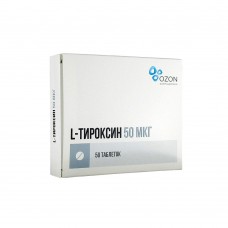Expiration date: 05/2026
Active substance: levothyroxine sodium
Pharmacology
Mode of action - complementary deficiency of thyroid hormones
Mechanisms include metabolic effects of receptor binding to the genome, changes in mitochondrial oxidative metabolism and regulation of the flow of cations and substrates inside and outside cells. At low doses, has an anabolic effect in the medium - stimulates growth and development, increase tissue oxygen demand, it regulates the metabolism of proteins, fats and carbohydrates, increases the functional activity of the cardiovascular system and central nervous system, in high - inhibits the production of thyrotropin-releasing hormone from the hypothalamus and pituitary thyroid stimulating hormone.
At intake 80% of the dose is absorbed almost exclusively in the upper small intestine, reducing the absorption of food intake. Serum Cmax achieved after about 6.5 hours after administration. Binding to serum proteins (thyroxine binding globulin, thyroxine binding prealbumin and albumin) - more than 99%. In various tissues occurs monodeyodirovanie levothyroxine sodium to form a triiodothyronine (T3), and inactive ingredients. Thyroid hormones are metabolized mainly in the liver, kidney, brain and muscles. A small amount undergoes deamination and decarboxylation as well as sulfuric acid and conjugated with glucuronic acid (in the liver). The metabolites are excreted in the urine and bile. T1 / 2 - 6-7 days. When thyrotoxicosis T1 / 2 is shortened to 3-4 days in hypothyroidism is extended to 9-10 days.
The clinical effect of hypothyroidism is manifested through 3-5 days. Early diffuse hyperplastic goiter decreases or disappears within 3-6 months, with the later stages of a significant reduction of nodal thyroid size is noted only in 30% of cases, but almost all patients prevented its further growth.
Application
Hypothyroid state of various etiologies (including those caused by surgical or medical exposure), prevention of relapse after resection of nodular goiter of the thyroid gland, diffuse euthyroid goiter; Graves' disease - after creating a euthyroid state tireostatikami (in the form of combination or monotherapy); thyroid cancer after surgery (for the purpose of suppression of tumor recurrence and as replacement therapy), as a diagnostic tool for the test thyroid suppression. In the combined therapy: Graves' disease, Hashimoto's thyroiditis.
Contraindications
Hypersensitivity, untreated thyrotoxicosis, acute myocardial infarction, acute myocarditis, untreated adrenal insufficiency (must be compensated before the start of therapy).
Restrictions apply
Coronary artery disease (atherosclerosis, angina pectoris, myocardial infarction), hypertension, arrhythmia, diabetes and diabetes insipidus, heavy long-existing hypothyroidism, malabsorption syndrome (may require dose adjustment), pituitary insufficiency, advanced age.
Pregnancy and breast-feeding
During pregnancy and breastfeeding levothyroxine sodium therapy, appointed about hypothyroidism, should be continued. During pregnancy, you want to increase the dose of the drug due to increased levels of thyroxine-binding globulin. The amount of thyroid hormone, secreted in breast milk (even during treatment with high doses of the drug) is not enough to cause any disorder in the baby during breastfeeding. Pregnancy in combination with tireostatikami contraindicated because receiving levothyroxine sodium may require an increase in dose thyreostatics. Since tireostatiki unlike levothyroxine sodium, can cross the placenta, the fetus may develop hypothyroidism.
Category effects on the fetus by FDA - A.
During the period of breastfeeding medication should be taken with caution, strictly at the recommended doses, under a doctor's supervision.
Side effects
Tachycardia, irregular heartbeat, chest pain, tremors, restlessness, insomnia, hyperhidrosis, weight loss, diarrhea, alopecia, disturbance of adrenal function (with pituitary or hypothalamic hypothyroidism), a disorder of renal function in children, allergic reactions (skin rash, itching skin).
Interaction
Reduces the effect of insulin and oral antidiabetic drugs, cardiac glycosides, enhances - indirect anticoagulants, tricyclic antidepressants. Cholestyramine, colestipol, aluminum hydroxide reduces the plasma concentration due to inhibition of intestinal absorption. Phenobarbital and phenytoin accelerate metabolic clearance, without increasing the fraction of free T3 and T4 in blood. Estrogens increase the concentration associated with thyroglobulin fraction (less effective). Alter binding protein anabolic steroids, asparaginase, clofibrate, furosemide, salicylates, tamoxifen. Amiodarone, aminoglutethimide, aminosalicylic acid, ethionamide, antithyroid drugs, beta-blockers, carbamazepine, chloral hydrate, diazepam, levodopa, dopamine, metoclopramide, lovastatin, somatostatin et al. Can alter the levels of thyroid and thyroid-stimulating hormone, usually affecting the synthesis, secretion , distribution, metabolism, or elimination of the action of thyroid hormones or altering the secretion of TSH.
Overdose
Symptoms: thyrotoxic crisis, sometimes delayed for several days after ingestion.
Treatment: the appointment of beta-blockers in / with the introduction of corticosteroids, plasmapheresis.
Dosing and Administration
Inside, in the morning, on an empty stomach, drinking a small amount of liquid. The daily dosage is determined individually depending on indications.
In hypothyroidism: an initial dose for adults - 25-100 mg / day, with a gradual increase (25-50 mg every 2-3 weeks) to maintenance - 125-250 mg / day; after surgery for a malignant tumor of the thyroid - 300 mg / day.
Babies: the initial dose - 12.5-50 mg / day; Prolonged treatment with a maintenance dose of calculating oprelelyayut 100-150 g / m2.
To conduct the test supressionnogo - 14 days 200 mg per day, or 1 mg 3 times per 7 days before re scintigrams.
Euthyroid goitre and prevention of its recurrence after resection: adults - 75-200 mg / day, children - 12.5-150 mg / day.
Precautions
It is recommended to periodically determine blood levels of thyroid-stimulating hormone, an elevated level which indicates a lack of dose. The adequacy of thyroid suppressive therapy is estimated also to suppress the capture of radioactive iodine. When long-existing multinodular goiter prior to treatment should be carried out with the test stimulus thyrotropin-releasing hormone. In most cases, hypothyroidism, metabolic status should be restored gradually, especially in elderly patients and patients with cardiovascular disease. For elderly patients the initial dose should not exceed 50 mg. When applied in the II and III trimester usually increase the dose by 25%. With caution is prescribed for severe long-existing hypothyroidism. Before treatment should eliminate the possibility of pituitary or hypothalamic hypothyroidism.



